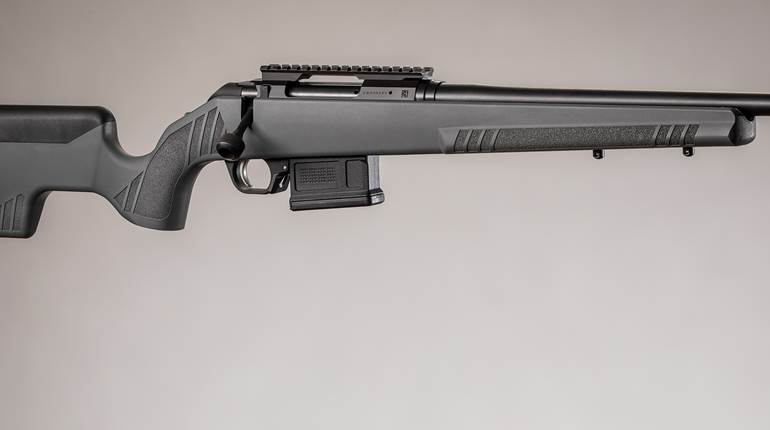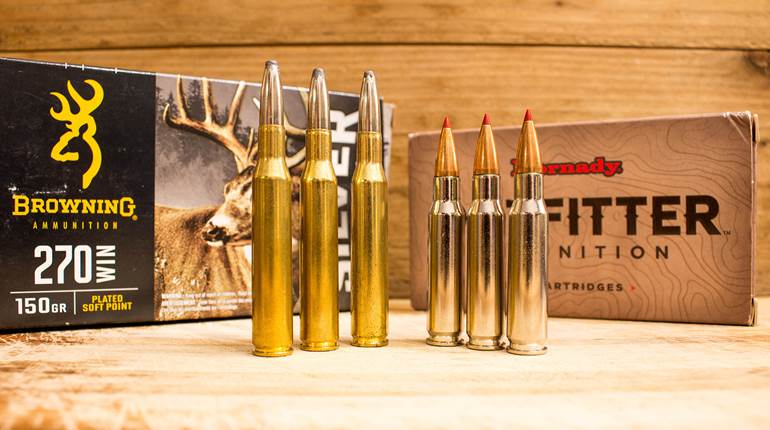
The .308 Win. works well with a variety of bullet weights. Good examples include (from left): Sierra’s 125-gr. Pro-Hunter, Berger’s 125-gr. FB Target, Nosler’s 150-gr. AccuBond, Hornady’s 168-gr. A-MAX and Sierra’s 180-gr. Pro-Hunter.
The .308 Winchester provides middle-of-the-road ballistic performance, yet produces first-rate utility. The cartridge’s enormous popularity (second only to the .223 Rem. among center-fire rifle cartridges) has created a wealth of bullets and propellants aimed at everything from reloading for practice, target shooting and hunting.
 Young hands appreciate the ease of handling a lightweight rifle, and someone starting down the hunting trail needs plenty of practice. But the recoil of regular .308 Win. loads shot from a 6-lb. Ruger American Compact may cause a sensitive shoulder to wince. Reducing recoil by way of decreasing bullet weights and propellant charges is likely to encourage meaningful practice.
Young hands appreciate the ease of handling a lightweight rifle, and someone starting down the hunting trail needs plenty of practice. But the recoil of regular .308 Win. loads shot from a 6-lb. Ruger American Compact may cause a sensitive shoulder to wince. Reducing recoil by way of decreasing bullet weights and propellant charges is likely to encourage meaningful practice.
The recoil created by 125-gr. projectiles loaded with 38.5 grs. of H322 (listed in the load table), is nearly half that of full-measure loads with 150-gr. bullets. A nice feature of this reduced load is that the bullets hit only 1" below full-power 150-gr. bullets and 1" above 168- and 180-gr. bullets at 100 yds., so sight adjustment can remain the same, whether punching paper or hunting.
But these light amounts of propellant slosh around in a .308 Win. case, leading to wide swings in velocity. The 38.5 grs. of H322 loaded with Sierra 125-gr. bullets, listed in the table, is 4.9 grs. below the maximum listed in the Sierra Bullet Infinity 7.0 program. That combination produced a 101 f.p.s. spread over 10 shots. The load still shot fine, although with some vertical stringing. In contrast, Berger 125-gr. bullets turned in a much narrower spread of 42 f.p.s. with a near-maximum charge of TAC that fairly well filled a .308 Win. case. Heavier bullets produced similarly low velocity spans.
Not much speed is required for a bullet to punch through the ribs of a deer standing broadside out to 150 yds. Hornady 150-gr. SST bullets paired with 41.0 grs. of IMR 4895 produced a mild speed of 2473 f.p.s. from the 18.5" barrel of a Mossberg MVP Flex rifle in .308 Win. Hornady states SST bullets readily expand at impact speeds down to 2000 f.p.s, which that load slows to at 225 yds. If there is any concern about adequate bullet expansion at these slower speeds, simply load bullets intended for the .30-30 Win.
The .308 Win. easily picks up the pace shooting larger game and longer distances, but cannot spare any bullet speed for such pursuits. The 16" barrels of various “scout” rifles lose upwards of 100 f.p.s of velocity compared with the same loads fired through 18.5" barrels, and they give up 125 f.p.s when compared to 22" barrels. And, in my opinion, these abbreviated barrels are no handier than a 20" barrel.
A 20" barrel provides quite acceptable bullet speed for the 40-some grains of propellant the .308 burns. The 20" barrel of the Mossberg MVP Predator rifle, used to shoot the loads in the accompanying table, fired 150-gr. bullets at nearly 2800 f.p.s. and 180s close to 2700 f.p.s. A .30-'06 Sprg. with the same length barrel won’t exceed those speeds.
For deer hunting, 150-gr. bullets and the .308 Win. match like wool socks and winter. Traditional bullets, such as Hornady InterLock and Sierra Pro-Hunter, are tough to beat for price and for performance at .308 speeds. Some hunters, though, want the assurance bullets will hang together on iffy angles and tough animals. Barnes Tipped Triple Shock, Nosler AccuBond and Hornady GMX bullets provide that surety. Top speeds for those bullets come from propellants such as TAC, IMR 4064, CFE 223, IMR 4895, Reloder 15 and A2460.
The Mossberg’s skinny barrel felt hot enough to light a cigar after firing 10 shots. Still, the hunting rifle shot Hornady 168-gr. A-MAX bullets reasonably precisely when paired with Reloder 15. Other propellants, such as IMR 3031 and 4895, TAC, and W748, have provided good accuracy with target bullets in other .308 rifles.
The consensus is to shoot heavy bullets when hunting large game like elk and giant black bears. That’s good advice with regular bullets, say Sierra 180-gr. Pro-Hunters. However, 200-gr. bullets are too much for the .308’s moderate-size case, causing a steep decline in velocity and trajectory.
Bullets that ration expansion are a better bet for these big animals. Bullets such as the Nosler AccuBond or Hornady GMX hold onto most of their weight no matter what they encounter in the woods. That maintained weight allows shooting 150- to 165-gr. bullets—the perfect weights for the .308—which produce a trajectory a few inches flatter at long distance than 180s.
Two seasons ago, I shot a six-point bull elk as it stood quartering away at 237 yds. The 165-gr. GMX fired from my Mossberg .308 hit the bull in the rear rib, punched up through the lungs and lodged under the hide in front of the far shoulder. The bull pitched off the mountain, but made it only 60 yds. before it fell dead.
The following spring, in Northern Alberta, my guide and I were filling the bait barrel with popcorn. A black bear came out of the bush at a determined pace for the bait.
“Big bear,” the guide said, stepping back.

I stepped forward and fired my .308 to my immediate benefit. The GMX bullet dropped the bear dead right there.
Repurposing Surplus Brass
The supply of new cases for handloading remains erratic, and when .308 Win. cases are available they cost at least 50 cents apiece. To keep my .308 rifles shooting, I bought a box of 500 once-fired military surplus 7.62x51 mm NATO cases from Everglades Ammo and Reloading (evergladesammo.com) for $85 delivered to my door.
The cases were clean, bright and shiny as new. The bulk of the cases were Lake City, but headstamps also included “FC” (Federal Cartridge) and “RA” (Remington) with the NATO insignia headstamp of a cross in a circle from various years. They were 0.011" longer measured to the datum point of the shoulder than Hornady commercial cases fired in my .308 Mossberg bolt-action and Colt autoloader. A size die set the shoulders back to the proper headspace dimension. Trimming the cases to the correct length and removing the crimp around the primer pocket finalized them for loading.
Military cases are usually thicker and have less internal capacity than commercial cases. That was true of the Lake City cases that weighed 12.8 grs. more and had 4 percent less total capacity than Hornady cases. To compensate for that smaller volume, I reduced maximum powder charges listed in handloading manuals by about 4 percent and mostly use them for low-pressure cast bullet and practice loads.





































